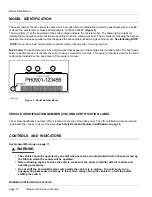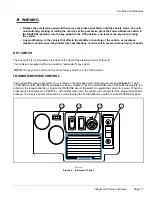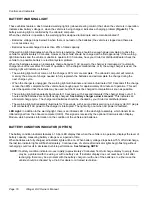
General Warnings
WARNING
• Follow the procedures exactly as stated in this manual, and heed all DANGER, WARNING, and
CAUTION statements in this manual as well as those on the vehicle and battery charger.
• The driver must possess a valid, unrestricted driver’s license issued by the State in which the vehicle
will be operated.
• The driver and passenger must be restrained at all times with the seat belts provided to help prevent
injury in the event of sudden braking or collision.
• Do not allow people to ride in any part of the vehicle that is not equipped with a seat and a seat belt.
Do not allow a third person to sit in the middle of the seat or let a passenger hold a child in his or
her lap while the vehicle is moving.
• Do not leave children unattended on vehicle.
• The vehicle is not designed to meet child seat compatibility requirements. Children requiring a child
safety seat must not ride on the vehicle. Comply with state and local laws pertaining to child safety.
• Prior to leaving the vehicle unattended or servicing the vehicle, set the park brake, place the
Forward/Reverse handle or switch in the NEUTRAL position, turn the key switch to the OFF position,
and remove the key. Chock the wheels when servicing the vehicle.
• Improper use of the vehicle or failure to properly maintain it could result in decreased vehicle
performance, severe personal injury, or death.
• Any modification or change to the vehicle that affects the stability or handling of the vehicle, or
increases maximum vehicle speed beyond factory specifications, could result in severe personal
injury or death.
• Check the vehicle for proper location of all vehicle safety and operation decals and make sure they are
in place and are easy to read.
• For vehicles with cargo beds, remove all cargo before raising the bed or servicing the vehicle. If the
vehicle is equipped with a prop rod, ensure that it is securely engaged while bed is raised. Do not
close bed until all persons are clear of cargo bed area. Keep hands clear of all crush areas. Do not
drop cargo bed; lower gently and keep entire body clear. Failure to heed this warning could result in
severe personal injury or death.
• Only trained technicians should service or repair the vehicle or battery charger. Anyone doing even
simple repairs or service should have knowledge and experience in electrical and mechanical repair.
The appropriate instructions and precautions must be used when performing maintenance, service, or
accessory installation.
• Place Tow/Run switch in the TOW position before disconnecting or connecting the batteries. Failure to
heed this warning could result in a battery explosion or severe personal injury.
• To avoid unintentionally starting an electric vehicle, disconnect the batteries and discharge the
controller. See Disconnecting the Batteries – Electric Vehicles on page 13.
• Ensure battery connections are clean and properly tightened. See Battery Care – Water Quality on
page 34.
• Use only 4-gauge (AWG) wires with low-resistance terminals to replace battery wires on the vehicle.
• Wear safety glasses or approved eye protection when servicing the vehicle or battery charger. Wear a
full face shield and rubber gloves when working on or near batteries.
• Do not wear loose clothing or jewelry such as rings, watches, chains, etc., when servicing the
vehicle or battery charger.
• Use insulated tools when working near batteries or electrical connections. Use extreme caution to
avoid shorting of components or wiring.
DISABLING THE VEHICLE
1.
Set the park brake.
2.
Turn the key switch OFF and remove the key.
Page 12
Villager LSV Owner’s Manual















































